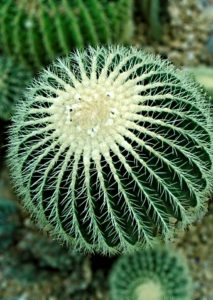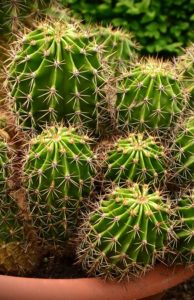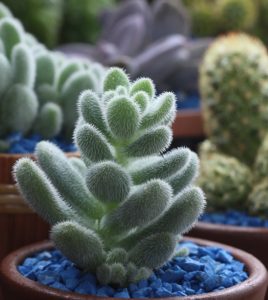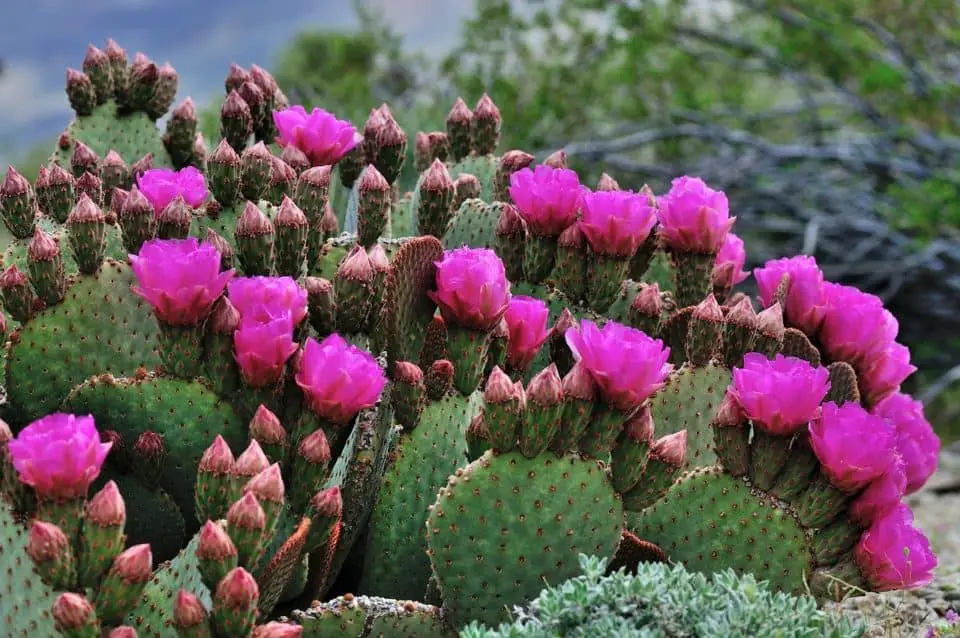Some links in the post are affiliate links and I get a commission from purchases made through some links found in the post.
You may find that your cactus is not doing well despite having fixed the causes of the browning, check this article if you have not already.
In this case, you need to look at what’s stressing the plant and fix it before things take a turn for the worse.
The good news is that cacti are hardy plants and can withstand problems that other plants cannot.
Even so, you still need to act in haste and get to the root of the problem. Let’s cover some issues you may want to look into:
Why is Your Cactus Dying?
There are many reasons why your cactus may be dying.
This includes root rot, watering inconsistencies, compacted roots, potting mix hiccups, lighting issues, pest infestations and fertilization deficits.
Cactus Root Rot
Root rot could induce browning in your cactus, causing a change in hue at the plant’s base.
This common problem is easy to fix if you catch it before it has taken too much of a toll on the plant.
Common signs include browning at the plant’s base, loss of stiffness, mushiness in the roots, and a change in hue in the roots. As the root rot progresses, the plant may start turning black.
What Causes Root Rot?
 The cactus roots might be compromised due to overwatering, inadequate drainage holes, and a poor choice in potting mix.
The cactus roots might be compromised due to overwatering, inadequate drainage holes, and a poor choice in potting mix.
You see, cacti roots are shallow, which helps them collect water when out in their native environments.
However, it also works against them if they are left in the water all the time, which can trigger rotting, thus damaging the roots.
To ensure that root rot is behind the change in plant color, you need to remove the plant from the pot and inspect its roots.
If they appear healthy with no apparent mushiness, something else is to blame.
However, if they appear soggy and mushy, you will need to act fast before the damage progresses.
Cut off the damaged parts and apply sulfur to the wounds to initiate healing.
Proceed to repot the cactus plant in a new potting mix and avoid watering it for a while to enable the wounds to heal. Over time, the cactus will thrive again.
Please note that in some cases, the root damage is so extensive that you cannot possibly save the plant.
You can still try to get rid of the damaged parts and save what’s left.
If this does not prove effective, you may want to get cuttings from the dying cactus plant and use these to propagate a new plant.
The resulting cactus plant will be healthy, and you can start from scratch and avoid the mistakes you made with the parent plant.
Cactus Watering Inconsistencies
It’s easy to forget that the cactus is a desert plant once you start growing it indoors. You may even find yourself treating it like a plant that needs water on the daily.
It’s a recipe for disaster, and you can end up drowning the roots and triggering root rot which can kill the cactus plant.
As such, you need to question how much water you’ve been giving the plant and if you might have gone overboard.
Less is always more in the case of the cactus. Giving it inadequate water is another problem that can arise.
You may have treated the plant like too much of a desert plant, thus depriving it of essential nutrients and pushing it towards its slow death.
Are you Overwatering your Cactus?
Warning signs include an onset of mushiness in the cactus plant as well as changes in the roots.
While root rot might not have started, you may notice that the plant overall looks like it could do with less water.
Likely causes include overwatering, poor drainage, and a poor choice in potting mix.
If everything else checks out, you may want to start by reducing the water you give the cactus plant or adjusting the frequency.
Ideally, you should only water the plant when the two top inches of the soil are dry. If not, wait a while and check the next day.
In colder regions, you may find that you only need to water the plant once or twice a week.
Please note that the pot size can also be to blame. The pot could be holding too much water because the plant’s roots take up most of the space, and some root binding has begun.
It might be time to move the cactus to a much bigger pot.
Are you Underwatering your Cactus?
Growing desert plants can be a bit of a conundrum. You don’t want to give them too much water because this can drown them.
And you also don’t want to leave them to fend for themselves because they will die. Striking a balance is easier said than done.
The good news is that your cactus will not need much water, and if you skip watering now and then, it will hardly suffer.
However, going for long periods without watering the plant can hurt it, which shows as browning, brittleness, shrinking, and the development of wounds.
If the plant looks like it could do with some more water, start slow and give it some to revive it. As you build the watering schedule, you will learn how much your plant needs to stay alive.
If all else fails and you cannot strike that balance, a moisture gauge can help you avoid the guesswork!
Cactus Compacted Roots
 Like many other houseplants, the cactus can also outgrow its current container, and when this happens, the plant starts to suffer and can die if you do not act on the warning signs.
Like many other houseplants, the cactus can also outgrow its current container, and when this happens, the plant starts to suffer and can die if you do not act on the warning signs.
Cactus grow their roots wide, and if the space is not adequate to accommodate this growth, the roots end up crowding each other.
This will start preventing each other from absorbing water and nutrients vital to the cactus’s growth.
The first warning sign is a decline in growth, such that the plant seems to be stuck to a given height.
Secondly, the roots will seem to have filled the pot, and some will even stick out above the soil.
Depending on the root coverage, some roots may poke out of the drainage holes.
Thirdly, you will notice that the water moves through the container almost immediately when you water the plant, leaving very little available for the cactus.
And finally, the plant will look overall unhealthy. Does this describe your plant? If yes, it’s time to repot it by moving it to a much bigger pot that can accommodate its size.
Repoting is quite easy. First, you need to find a sterile pot that is one or two sizes bigger than the current pot.
You don’t want to go with an extremely large pot as the cactus will focus more on spreading its roots than growing leaves, and you will be back to square one in no time.
Also, a much bigger pot will hold more water and can trigger problems such as root rot. One or two sizes more will be enough to give your plant the growing environment it needs.
Cactus Potting Mix Hiccups
If none of the issues above seem to be the cause behind the dying cactus, you may want to take a closer look at the soil.
It may be home to pathogens that could be attacking your plant and triggering root rot.
Thus, even if you change your watering patterns or the pot or even repot the plant, the problems will not cease as long as you use the same soil.
Even where pathogens are not the culprit, the potting mix may not be ideal for the plant.
The ideal mix should be well-draining and well-aerated, holding just enough water and allowing the excess to drain.
If this is not the case, the soil can hold way more water than the cactus needs, again triggering root rot.
When changing the potting mix, go with a porous choice. Luckily, you can find such mixes in nurseries or stores.
Or you can follow simple guidelines online suited for cacti and create one that’s suitable for your plant.
You may also like: Quick ways to Propagate a Christmas Cactus
Lighting Issues for a Cactus
The cactus does best when it has access to adequate light. Please note that this does not mean full exposure to the sun.
While many cacti varieties can handle bright sun exposure for long hours, some suffer from this and suffer browning, as we covered earlier.
However, low light is not the solution, and plants in such conditions show signs of paleness and floppiness. In some cases, the cactus can even shed its leaves, signaling a slow death.
First, you need to figure out how much light your variety needs.
If more lighting will do the plant some good, move the plant near a window, slowly increasing its exposure, and see if it perks up again.
You can even try artificial lighting, slowly increasing the light as the cactus starts to show signs of better health.
Be careful with the lighting, as too much can cause a change in hue in the plant’s leaves.
The burning starts as a white discoloration before moving on to a brownish hue on the leaves, which is irreversible which can then lead to the cactus dying.
Cactus Pest Infestations
Even indoors, your plant is not safe from pest attacks, and you may need to look into if this is why the plant seems to be losing the fight.
In particular, you need to watch out for mealybugs that make a home in the plant and feed on it, thus slowly killing it.
You will notice a reduction in the plant growth and an overall reduction in the plant’s aesthetics, giving it a dull look.
Whether it’s mealybugs, mites, or any other pests, the sooner you act, the easier it will be to save the plant.
While these pests may seem small, they can wreak havoc not only on the cactus but surrounding plants as well, killing them all.
Natural remedies include wiping the plant with denatured alcohol, using smoke cones on the bugs, and using a mild detergent on the plant.
Given the repetitive nature of these methods, you can also opt to use insecticides, more so when your home has other plants at risk and to stop your cactus from dying
Fertilization Deficits for a Cactus
Often, gardeners will not think of fertilizing their cacti. Once again, it owes to the notion that these are hardy plants that barely require gardeners to lift a finger when growing them.
While many cacti can do well without additional input, some require a boost now and then, especially when the original potting mix is bland.
If you have looked at all the above issues and cannot seem to find one specific to your plant, underfeeding could be the problem to stop your cactus from dying.
You need to find a fertilizer suited to cacti and use it on the plant every two weeks during the active growing months.
 Come fall and winter; you can reduce the feeding to once a month. If such a routine seems hectic, you can even feed the plant once a year as long as it does not show signs of underfeeding.
Come fall and winter; you can reduce the feeding to once a month. If such a routine seems hectic, you can even feed the plant once a year as long as it does not show signs of underfeeding.
Now, while underfeeding is a problem, overfeeding is just as bad.
And you can easily tell that the plant has had more than enough when its leaves get soft, brittle, turn brown, and the plant looks unhealthy.
You are much safer giving the plant less than it needs than going overboard because you would end up having to change the potting mix.
To be safe, look at the manufacturer’s instructions and follow them to the letter.
Also, dilute the fertilizer by as much as half its strength because cacti do not need that much fertilizer. Else, the plant can suffer root damage.
Alternatively, you can leave the plant be and allow it to go through its natural phases.
Final Thoughts: Why is Your Cactus Dying?
The cactus will not always look sharp and healthy. Sometimes, it needs to die down and shed its buds before springing to life again, and nothing you do can prevent this change.
As long as you give it the care it deserves, and nothing seems out of place, the plant will soon be fine.
Happy Gardening!
If you enjoyed this article, check out our article on the jumping cholla vs the teddy bear cholla.

